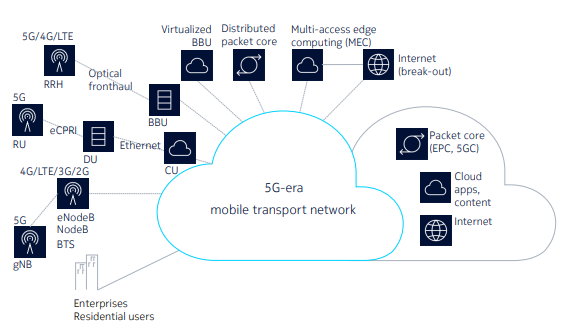The transport network is a crucial part of the whole 5G solution. It is the unifying network fabric that must deliver new performance, reach and capabilities to address demanding new requirements.
• Extreme bandwidth for enhanced mobile broadband (eMBB) demands a new generation of terabit capacity networking products that can support multi gigabit cell site connectivity and network-facing interfaces for link speeds up to 100 GE. These products must be delivered in a variety of compact form factors and support temperature hardening for outdoor applications.
• Low latency in the transport network is an infrastructure enabler that will aid the functional split in the RAN and evolution to packet-based fronthaul. Low latency is also an enabler of new types of applications, including edge computing and AR/VR. The transport network requires a new generation of hardware and software that can support end-to-end delays of less than 10 ms.
• Enhanced QoS must support parallel business cases for eMBB, ultra-reliable low latency communications (uRLLC) and mMTC, along with network slicing. To meet these needs, the transport network must deal with multi service traffic that may come from several mobile generations simultaneously.
• Dynamic inter connectivity refers to new, flexible and agile ways of combining physical and virtualized network functions, and diverse and distributed sets of network parts and domains such as RAN, packet core and edge cloud. To support dynamic inter-connectivity, the transport network must complement new product capabilities such as programmability with innovative networking techniques.
• Improved network synchronization capabilities are required to support 5G’s more stringent timing, frequency and phase synchronization requirements. The transport network must provide robust.
• Programmability has become an essential network attribute. Networks need to be programmable to support SDN-based control and automation and gain the flexibility required for techniques such as network slicing.

Source: Nokia white paper
